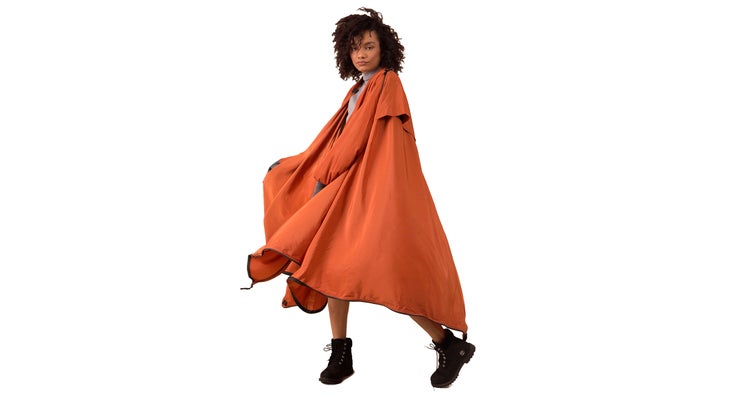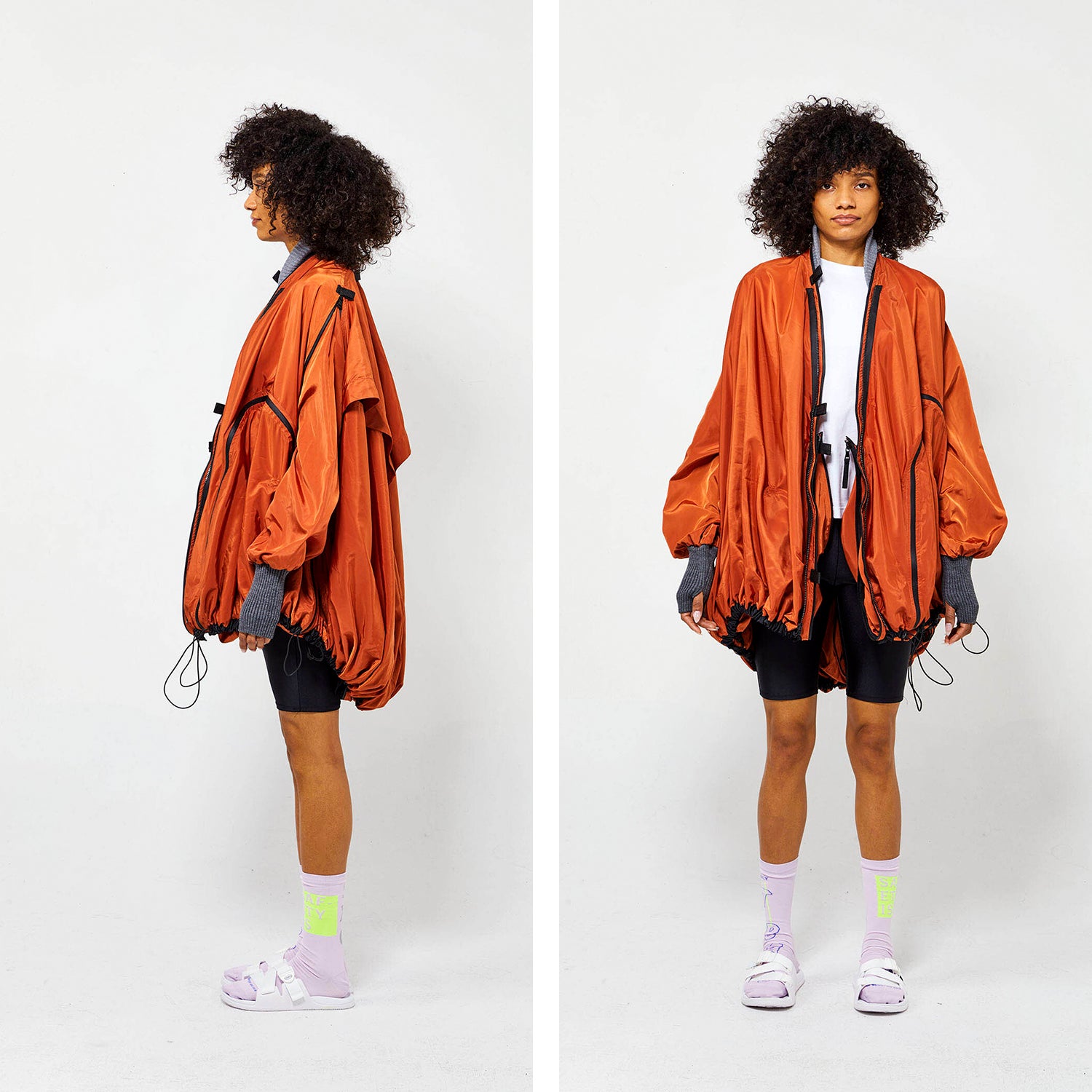Fashion designer Angela Luna started exclusively buying new clothing for herself from small, person-of-color owned, and sustainable businesses in 2015. These days, she more often opts for eighties trousers from her favorite vintage boutique in Brooklyn or upcycled statement pieces from her brand Adiff, the humanitarian clothing label she started right out of fashion school.
In a , Luna asks the audience, “What if a shirt could save lives? Why are we assuming that fashion doesn’t have the potential to do so?” A year later, she made Forbes’s “30 Under 30 Art and Design” list for her work through Adiff, short for “make a difference.” And that’s just what the brand aims to do.
Some of Adiff’s most eye-catching garments, like a billowy trench coat that turns into a tent, a piece that looks straight out of Blade Runner, are conversation starters for social and environmental issues Luna says we can’t ignore. You might have seen it��on Pattie Gonia, the environmentalist drag queen paired with patent leather boots and a red wig. Luna also helped Pattie design dresses out of ocean plastic for a . But she originally created the coat as part of her thesis collection of unisex convertible garments for refugees, which also included a sleeping bag jacket and a backpack with a rain hood. The project ultimately kept her from quitting Parsons School of Design in her final year—after seeing the heartbreaking photo of a drowned Syrian boy on a beach made her want to drop out and join the Peace Corps. Luna decided that if she could leverage the fashion industry to care about global issues, her degree wouldn’t be for naught.

Adiff formally launched in 2016, but a 2018 Kickstarter with a $100,000 goal funded its first run of Reflective Reversible Jackets on a buy-one, give-one model. Luna designed the garment to help its wearer stand out or blend in, depending on the survival circumstance. After a successful campaign, about 500 jackets from that production run went to refugees in Syria and Turkey. Next she produced the sought-after Tent Jacket in Kharkiv, Ukraine, where she knew of a factory that was willing to take on the production challenge of making such a complicated piece. Later in 2018, Adiff opened a factory in Athens, Greece. A team of resettled refugee tailors from Afghanistan experimented with rescued materials, such as United Nations’ Refugee Agency (UNHCR) tents and life jackets that were otherwise trash, to create the brand’s line of bags, backpacks, and fanny packs.
Adiff’s commitment to upcycling, or reusing existing and recycled materials rather than sourcing virgin fabrics, is part of a broader trend bridging both the fashion and outdoor industries, with brands like Fjällräven, Patagonia, The North Face, and Cotopaxi��either reselling used gear and clothing or debuting collections made from scraps and deadstock fabric.
The company also recently partnered with Nike to repurpose material for a pop-up show in New York City, and Lands’ End to debut a limited collection of denim totes, bucket hats, and pouches sewn from 1,500 pounds of denim scraps. “If the industry as a whole committed to a systemic form of change, we would certainly see an impact in waste reduction across the board,” says David Witkewicz, senior vice president of design at Lands’ End.
Even with the best intentions though, a handful of brands barely makes a dent in a broken system. Only a seismic shift could reverse the failures of the textile and apparel industry, which accounts for up to eight percent of worldwide carbon emissions and is second behind the oil industry when it comes to pollution, . “Humankind doesn’t have much time,” says Simone Cipriani, founder of the Ethical Fashion Institute of the International Trade Centre, a joint agency of the UN. These days, sustainability reports are just as important as fashion reports, he adds.
But because the textile and clothing industry employs 300 million people worldwide and contributes $2.4 trillion to the global economy, the industry can’t stop on a dime even with unsustainable and unethical practices embedded into the supply chain. Companies are usually locked into yearlong contracts, and even once those expire, they don’t always have the bandwidth to start from scratch and go looking for the cleanest, greenest suppliers and manufacturers. Even as a nimble startup, Adiff isn’t immune to logistical hangups. Consistency in the quality and quantity of upcycled materials is more difficult to predict. And the Adiff-owned factory in Greece was forced to close last year due to pandemic-related supply chain troubles; the brand has since halted production to seek manufacturing alternatives.
The pause has given Luna and her business partner, Loulwa Al Saad, time to evolve the business. Rather than solely selling expensive gear (the tent jacket is priced at $300), they’re transitioning into more of an educational resource and design studio. That way they can transcend their silo to help the greater textile industry work toward true sustainability—both from the social and environmental perspective.
In January 2021, they published the Open Source Fashion Cookbook, the duo’s brainchild for democratizing the sustainable fashion industry and teaching consumers how to affordably reinvent items already in their possession. In partnership with brands like Zero Waste Wardrobe, Brownmill, and CHROMAT,��which shared patterns of their designs, Luna and Al Saad co-authored the sewing guide ( or) for turning old bedsheets and broken umbrellas into something wearable and fashionable. “At the end of the day, the most sustainable piece is the one that’s already in your closet,” Luna says. A handful of industry ��������— of and textiles researcher , to name a couple—also contributed essays on topics ranging from fashion’s connection with colonialism to conscious consumerism.��
Later this summer, Adiff is launching non-fungible tokens, or NFTs, to create more exposure for the brand and opportunities to fund mission-driven projects. Two- and three-dimensional versions of the Tent Jacket will be accessible in multiple metaverses, which will hopefully allow Adiff to fund another run of the dual-function layers and once again employ refugees and immigrants.
While Adiff is small, its reach is greater when it can team up with the industry’s leading companies.
“I like to say we’re like the mushroom of the fashion industry—we take all the waste of these larger corporations and turn them into new things,” Luna says.��


